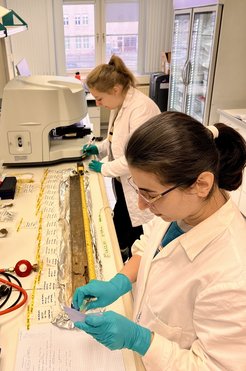Palaeoecology and Palaeobotany Laboratories

The Palaeoecology laboratories house state-of-the-art palaeoecological facilities to analyze an array of palaeovegetation proxies, including pollen, phytoliths, and starch grains. The laboratories are equipped with a positive-displacement laminar flow hood to provide a contamination-free environment for preparing and analyzing ancient samples. The labs host a Nicolet iN10 Fourier-transform infrared spectrometer (FTIR) for elemental analysis of pollen and charcoal and iCone Calorimeter for fire combustion experiments. The light microscopy section consists of three high-power Olympus microscopes fitted with digital cameras for direct imaging and measurement. A Keyence VHX6000 fully digital microscope possesses a continual magnification range from 10 to 2000x and provides auto-photo correction and stitching. The Keyence has a mobile lens allowing for the microscopic analysis of small artefacts as well as the surface of larger artefacts. The laboratories also include a JEOL InTouch Scope JSM-IT100LA compact SEM with an attached Energy Dispersive X-ray Spectrometer (EDX).
Beyond palaeobotanical applications, researchers use the microscopy facility to study and characterize a variety of archaeological materials, including cultural artefacts, teeth, bone, eggshell, pigments, and dental calculus.
